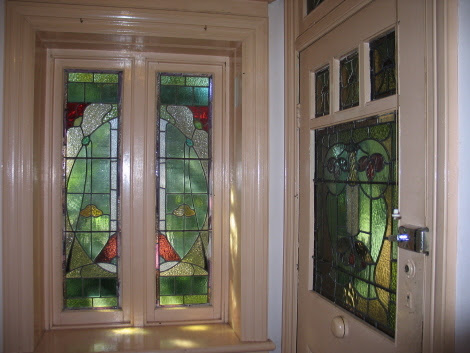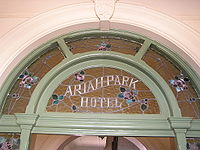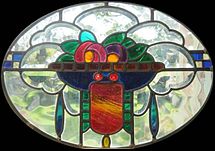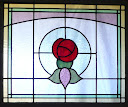Federation Leadlight Windows
Table of Contents
This post republishes material from the Artarmon NSW Progess Association and fromWikipedia on Leadlight Glass
 |
| 26 Yasmar Avenue Haberfield |
"Leadlights are decorative windows made of small pieces of glass supported in lead cames (frames). Glass may be clear or coloured and it may be plain, textured, bevelled or etched.
- http://www.artarmonprogress.org.au/Leadlights/pdf/Craft_of_Leadlighting.pdf
"The craft of leadlighting has been around for centuries and their designs are a reflection of the art of the day. The earliest versions were created by the Romans and Byzantines. From the thirteenth century churches and public buildings in Europe had elaborate leadlight windows such as the rose windows of Notre Dame Cathedral in Paris.
Following the Gothic Revival in architectural fashion, "leadlight windows started to feature in public buildings in Australia, such as the Sydney Town Hall from the 1880s. They were introduced into homes in the 1890s and were used extensively until 1939 when war time austerity led to less ornate domestic architecture."
- http://www.artarmonprogress.org.au/Leadlights/pdf/Leadlights_of_Artarmon.pdf
Description of traditional leadlight (Wikipedia)
 |  |  |
| A leadlight church window, Czech Republic, combines traditional diamond panes with the pale translucent and textured quality of modern so-called "cathedral glass". | A fine example of domestic leadlighting above the residential entrance of a 19th century Australian hotel shows the use of opaque glass so that the name might be visible both by day and night. | Domestic leadlight (1920s) employs an Art Decomotif in brightly coloured opalescent glass set in transparent glass which is both textured and cut with bevelled edges to reflect the light. |
- Stained glass windows, such as those commonly found in churches, usually include design components that have been painted onto the glass and fired in a kiln before assembly.
- The extra time and cost employed in painting and firing the glass usually prohibited its use in domestic architecture.
- While stained glass windows are found principally in churches and ornate buildings, leadlight windows, which rarely employ painted components, are much more common, and from the 1860s to the 1930s were a regular architectural feature in many private houses and cottages, where their style is often a clue to the age of the building.
- Unlike stained glass windows which are traditionally pictorial or of elaborate design, traditional leadlight windows are generally non-pictorial, containing geometric designs and formalised plant motifs.
- Leadlight windows almost always employ the use of quarries, pieces of glass cut into regular geometric shapes, sometimes square, rectangular or circular but most frequently diamond shaped, creating a "diaper" pattern.
- A further difference between traditional stained glass and leadlight is that the former almost always has painted pictorial details over much of the glass, requiring separate firing after painting by the artist.
20th century Leadlight (Wikipedia)
 |  |
| One of a series of large windows ofArt Nouveau design in Favrileand Cathedral glass, with the state's floral emblem, the waratah, Sydney Central Station, NSW, Australia. Despite the complexity, the execution was classed as "leadlighting". | An Art Deco domestic casement window,Melbourne, Australia, shows a wide variety of textured glass with some streaky glass in muted colours. |
"Prior to World War I, in domestic architecture, the front entrance remained the focus for decorative leadlighting. It was also commonly used for stair-well windows, but was uncommon in other locations where large panes of glass were valued over small ones.
- In domestic architecture, after World War I, the focus on the decoration of the front door became less common, and the front windows became the location of leadlighting.
- With the "bungalow" style of architecture becoming increasingly popular, sash windows were also often made with leadlighting, often incorporating sections of glass very much larger than in traditional diapered windows.
- This trend continued until World War II, the style evolving from Art Nouveau to Art Deco, which both employed a great variety of glass, including cathedral glass and opalescent glass, as well as bevelled glass.
- From 1940 until about 1980 domestic leadlighting was less common.
Note: Clicking on any picture below will lead to a larger version so you can see more detail
Features of an Art Nouveau style leadlight:
|  | Gallery of Leadlight in Federation Houses |
Art Nouveau Style Leadlight Doors
Federation homes (c.1900-1915) and early Californian Bungalows (c.1916-1925) typically had high-waisted, three panel doors with leadlights. |
| Artarmon Leadlight Door Sets |
| 24 Yasmar Avenue, HABERFIELD | 66 St Davids Road, HABERFIELD | Door sets at 7 Yasmar Avenue, HABERFIELD |
Art Nouveau Style Leadlight Windows
 |
| Artarmon NSW, examples of Art Nouveau style Leadlight Windows |
Some Federation (c.1900-1915) homes and early Californian Bungalows (c.1916-1925) have leadlights in the double, triple or quadruple casement windows of the front rooms.
 |
| Artarmon Art Nouveau Leadlight Windows |
| 160 Bland Street Haberfield | 23 Church Street Pymble | 101 Chandos Street, HABERFIELD | 32 Provincial Road Lindfield |
 |
| Heritage Listed 37 Dudley Street Haberfield with all front windows in leadlight |
Leadlights in Art Nouveau-Art Deco Transition Style
Many houses built before 1925 feature leadlights in designs representing a transition between the ornate and natural Art Nouveau and the simplified and geometric Art Deco styles. The designs are precursors to the final evolution of classical Art Deco.
- Lines have more subtle curves than classical Art Nouveau.
- Flowers in a representational form are used.
- Coloured glass is sometimes limited to a border or a central design.
- Many leadlights feature the ‘Macintosh (or Scottish) Rose’, an almost circular, stylised rose designed by Rennie Macintosh as part of his interpretation of Art Nouveau.
 This leadlight features gently curved lines and the stylised 'Macintosh or Scottish Rose' This leadlight features gently curved lines and the stylised 'Macintosh or Scottish Rose' |
 |
| California Bungalow designed by J. Burcham Clamp and Walter Burley Griffin with exquisite leadlighting |
 |
| Exquisite leadlights at 39 Robertson Road, Centennial Park, NSW |
Art Nouveau-Art Deco Transition Style Leadlight Doors
 |
| Artarmon NSW, examples of Transition style leadlight doors |
Federation homes (c.1900-1915) and early Californian Bungalows (c.1916-1925) typically had high-waisted, three panel doors with leadlights.
 |
| Artarmon NSW, examples of Transition style leadlight doors |
Art Nouveau-Art Deco Transition Style Leadlight Windows
 |
| Artarmon NSW, examples of Transition style leadlight windows |
Some Federation (c.1900-1915) homes and early Californian Bungalows (c.1916-1925) have leadlights in the double, triple or quadruple casement windows of the front rooms.
 |
| Artarmon NSW, examples of Transition style leadlight windows |







No comments:
Post a Comment